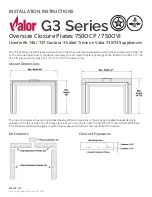
HearthStone Quality Home Heating Products, Inc ®
41
WFP-75 Model 8411
7 THE VENTING SYSTEM
7.1 GENERAL
The venting system, acts as the engine that drives your wood heating system. Even the best fireplace will
not function safely and efficiently as intended if it is not connected to a suitable chimney.
The heat in the flue gases that pass from the fireplace into the chimney is not waste heat. This heat is what
the chimney uses to make the draft that draws in combustion air, keeps smoke inside the fireplace and
safely vents exhaust to outside. You can think of heat in the flue gas as the fuel the chimney uses to make
draft.
7.2 SUITABLE CHIMNEYS
Your wood fireplace will provide optimum efficiency and performance when connected to a 6-inch diameter
chimney.
7.3 THE RELATIONSHIP BETWEEN THE CHIMNEY AND THE HOUSE
Because the venting system is the engine that drives the wood heating system, it must have the right
characteristics. The signs of bad system design are cold back drafting when there is no fire in the fireplace,
slow kindling of new fires, and smoke roll-out when the door is opened for loading.
7.3.1 WHY THE CHIMNEY SHOULD PENETRATE THE HIGHEST HEATED SPACE
When it is cold outside, the warm air in the house is buoyant so it tends to rise. This tendency of warm
air to rise creates a slight pressure difference in the house. Called ‘stack effect’, it produces a slightly
negative pressure low in the house (relative to outside) and a slightly positive pressure zone high in
the house. If there is no fire burning in a heater connected to a chimney that is shorter than the warm
space inside the house, the slight negative pressure low in the house will compete against the desired
upward flow in the chimney.
There are two reasons why the
chimney in the house at right will
cold backdraft when it is cold
outside and there is no fire burning
in the fireplace. First, the chimney
runs up the outside of the house, so
the air in it is colder and denser
than the warm air in the house. And
second, the chimney is shorter than
the heated space of the house,
meaning the negative pressure low
in the house will pull outside air
down the chimney, through the
fireplace and into the room. Even
the finest fireplace will not work well
when connected to this chimney.
7.4 CHIMNEY INSTALLATION NOTES
•
If possible, install an interior chimney as it will provide better performance. In areas with continuous
temperatures below
−
18
°
C (0
°
F), the use of an exterior chimney increases the likelihood of operating
problems such as low draft, high rate of creosoting, and poor start-up characteristics. Exterior chimneys
are also prone to down-drafting and flow reversal. Installations, which are located on lower floors in the
house, such as in a basement, in combination with outside chimney, are especially prone to flow
reversal.
•
The WFP-75 is listed only with chimney systems described in
Table 3.
•
A chimney venting a fireplace shall not vent any other appliance.
Содержание 8411
Страница 9: ...HearthStone Quality Home Heating Products Inc 9 WFP 75 Model 8411 2 3 DIMENSIONS General Dimensions ...
Страница 10: ...HearthStone Quality Home Heating Products Inc 10 WFP 75 Model 8411 Internal Dimensions Faceplate Projection ...
Страница 70: ...HearthStone Quality Home Heating Products Inc 70 WFP 75 Model 8411 SAFETY RATING LABEL ...
Страница 72: ...HearthStone Quality Home Heating Products Inc 72 WFP 75 Model 8411 ...
















































